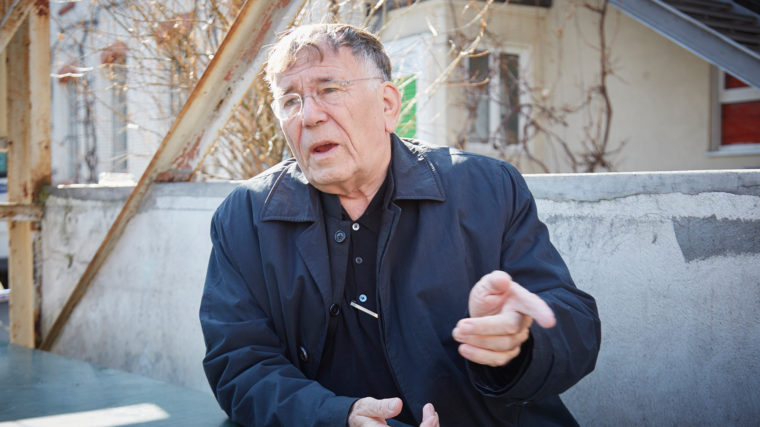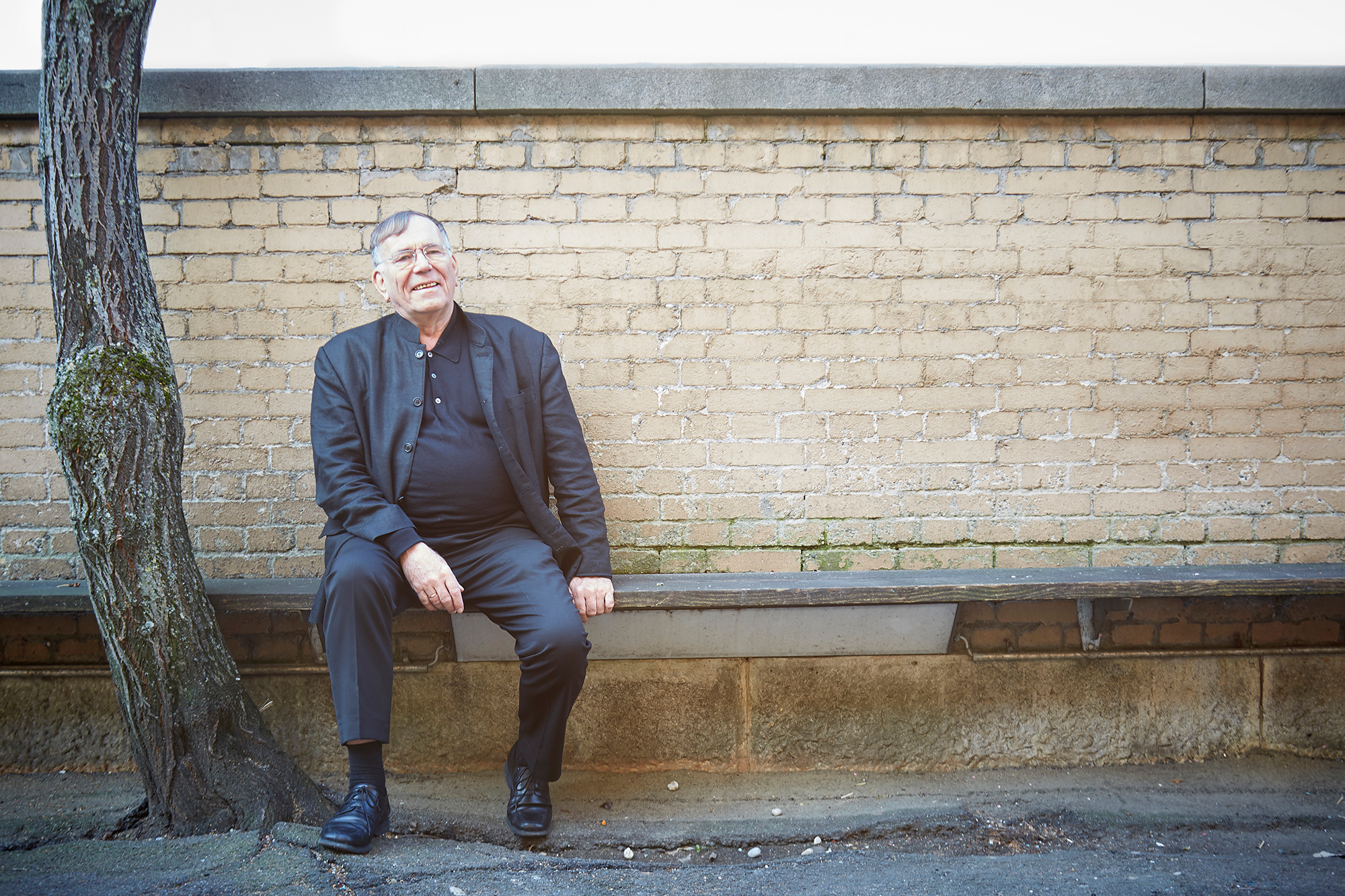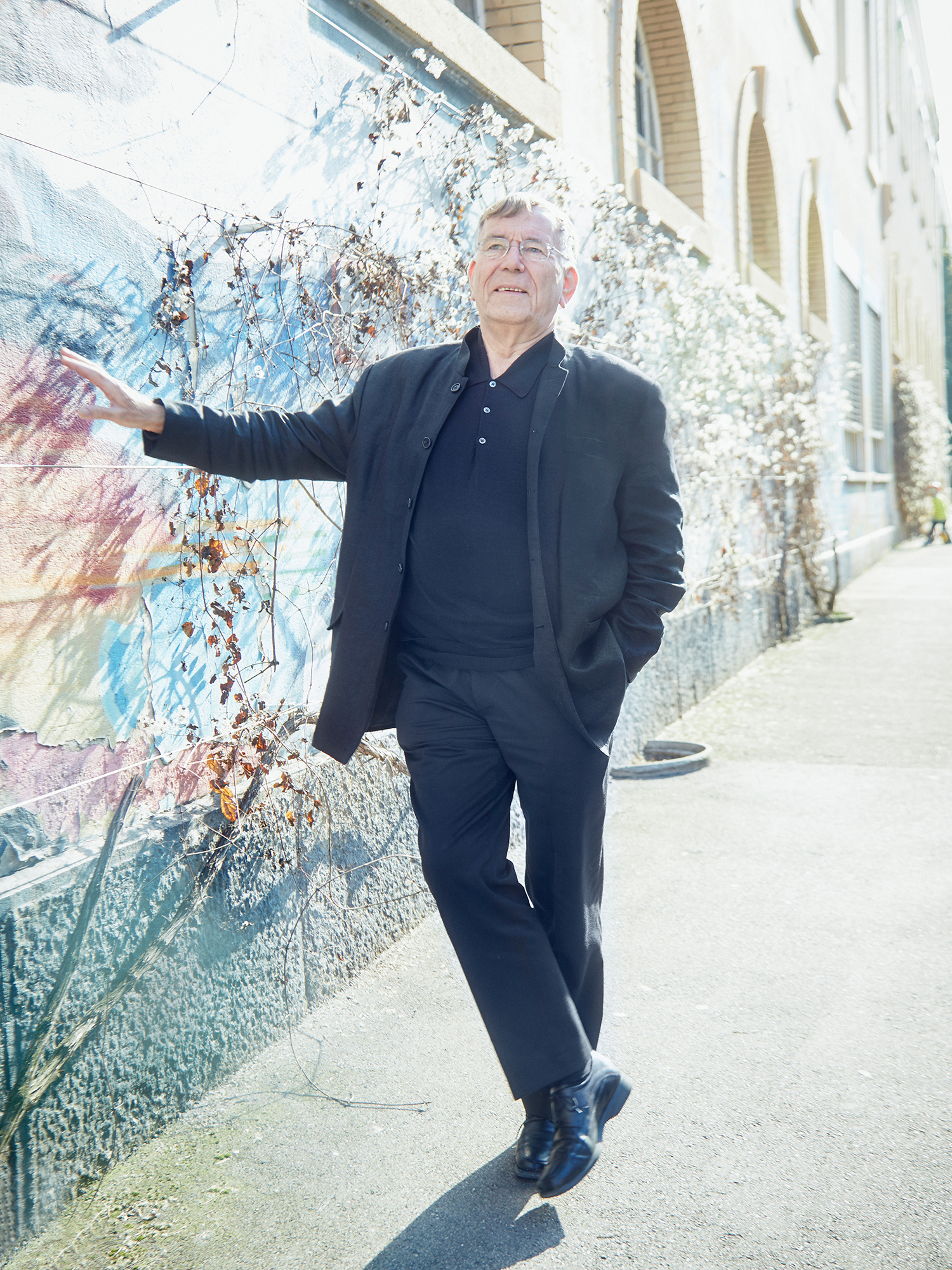He likes high-rises only from far away, he thinks cars should be banned from city-centers and he wants the public space to be the «living room of a city»: The danish urban planner Jan Gehl visited Basel on an official mission.
Zur deutschen Version dieses Artikels.
As adress of welcome Jan Gehl hands a business card. Printed on its back is a photography. It shows the typical yellow-red tram from Baselland. «This should be in Switzerland.» Gehl gathered the various pictures on his business cards during numerous travels.
Despite his hometown Copenhagen being one of the most liveable places of the world, the danish architect Jan Gehl gets about a lot. With his company «Gehl Architects» he helps cities around the world to build «cities for people». A few days ago, he visited Basel on invitation from the local planning department. We met him outside the «Gundeldingerfeld», where he held a well attended public lecture about sustainable cities the day before.
Jan Gehl, how many steps did you walk so far today?
I know that precisely (he fumbles for something and brings out a little red device). This is called a pedometer and it was given to me by the mayor of Kaliningrad. It says I walked 5000 steps so far, but actually it should be more. So I have to walk another 5000 steps today. You get seven more years to live, when you walk 10’000 steps a day.
Where have you been?
I have been walking around with these crazy people here all over this neighbourhood (Gundeldingen).
I’ve read somewhere that you like to stroll around a city and that you always bring your little camera along. What pictures do you take?
People mostly. People using public spaces. And I’m also interested in good solutions to planning problems. Or, of course, in silly solutions. I use this pictures in my presentations as I did yesterday. Or in my books. I’ve done this on five continents for fifty years. So I’ve got a lot of pictures by now. Pictures of people are always interesting. You can go on for hours looking at them, but by looking at pictures of houses or motorcars you will get bored pretty soon.
Did you take a picture in Basel too?
I haven’t had time to take many, because we worked a lot during my stay.
«The mutual love affair between people and their cars has waned.»
But did you take one? What drew your interest walking through the streets of Basel?
The first picture I took was of the little ferryboat on the Rhine, which was not propelled by anything but the sun and the streaming river. It’s genius. And I also took one of the Münsterplatz. I like it, it is a fine example of a good old city square. Its dimensions are within the human scale. You can still see the people standing at the far end. Modern squares are often built outside the human scale and therefore you lose sense of its dimension.
Just a few years ago, this exact square was regularly used as parking space. Now we have somehow managed to get rid of them.
This is a general pattern all over the world. The mutual love affair between people and their cars has waned. People start to think there might be other qualities in cities than just making space for cars.
It’s kind of a cliché to ask a foreigner if he likes Basel. But with you, it actually makes sense. Therefore, how do you like Basel?
Since I am only here for a short stay I can’t say too much. But I have the feeling that it is a nice city. Even more importantly, I feel that the spirit in the planning department and among the politicians I’ve met is promising. I truly believe these people are seriously working on improving this city. I feel confident and I feel comfortable.
However, a much more interesting question is: What didn’t you like about Basel.
One thing which I commented on, was the fact that there is a lot of asphalt in this city. Asphalt is for cars, busses and bicycles. In Basel cars and people all seem to have the same priority. Therefore I suggested that all pedestrian areas including sidewalks be celebrated by shifting them over a string of years into beautiful stone areas. This sends out a clear message: We would like you to be here and this public space should become the living room of the city.
You made Copenhagen one of the most liveable city worldwide. When do you start doing your magic in Basel?
I could start on Monday.
But you won’t?
No, I need an official invitation. But I can easily see that we could have fun together. We could increase the liveability in this city. Who knows, we might even find some kind of formal collaboration.
«Public space should become the living room of a city.» (Bild: Basile Bornand)
What advice did you give to our planners?
I am not a strong believer in giving advice after only 24 hours in any city. But my general advice to all cities is that they should do a systematic surveillance of what is going on in the city, how people are using it. It is exactly the same what traffic engineers have done for decades. They know everything about the life of traffic. And we generally know nothing about the lives of the people. It is a well known thing that you plan for the things you have information about. The things you know, you take care of. This is our message: Get information about how your city is used and then improve it where it needs improvement.
Your formula is quite simple: The fewer the cars, the more liveable a city is. In reality, there is a huge uproar with every parking slot that is taken away.
Only if it’s not done by God. Have God on your side and everything will be alright.
We have to pray for less traffic?
You could also provide information about how other cities have dealt with traffic. And that the level of traffic is something which can be influenced. People have to know that a city with less traffic is healthier, more sustainable, and more liveable.
How do you change people and their habits? For example: If someone doesn’t like walking and bicycling, this person will probably continue driving by car.
Let him. Because there will be other people who are more concerned about the environment and their health. The goal has to be to steadily increase the part of the public traffic which is done by your own energy or public transportation. Many cities around the world, small or large, have been quite successful in doing this. If it is attractive to use the bicycle, people will use it. If public transportation works well, people will use it. It has to become a good or even better alternative to your car. Traffic is like water, it goes where it can. And when it can’t go somewhere, it stops.
«Traffic is like water, it goes where it can.»
So it is more a question of options instead of rules?
We found people’s behavior depends on what you invite them to do. The more streets you have, the more traffic you get. A more attractive public realm will be used by more people. One example is the congestion-rate in London, where you have to pay eight pounds to enter the city-center with your car. The next day, there were 20 percent less cars. A city has the level of traffic it invites, also people tend to accept a situation when it is given by God. We found that it is easier to reduce traffic, if God helps us. For example when the Embarcadero Freeway, which was the lifeline to San Francisco, got destroyed by an earthquake everybody expected the city to die. But after three months they noticed that they had no problem at all. Today San Francisco is much more liveable thanks to that earthquake. That is why, when we start working in a city, we ask them «do you have earthquakes which can take care of this or that disruptive street?».
Yesterday after your lecture, someone asked you about participation. This is a huge subject in Basel. How can a city involve its inhabitants in urban planning?
I have been teaching architecture for 40 years. And I am a very strong believer in education and information. All these issues about making a liveable city for yourself and your children and your grandchildren is something that people are extremely interested in. My experience is that if you show people better alternatives, then they will understand. I think participation is great. But people have to be properly informed of what their options are. If you skip the information part and just say that you want to take away all the parking space in the city-center you will have a revolution. I always tell the same story: When my wife and I had our 45th anniversary we decided to take our bicycles to the restaurant and pedaled side by side through Copenhagen. We were both around 70 and we suddenly realized how much better our city has become. I think this is the most important thing: Every morning when you wake up, you have to feel that your city is a little better than the day before. That is a nice feeling, because it gives you hope for the generations to come.
This is your urbanistic vision. How do you prevent its corruption through compromises?
Of course there are compromises. And of course when we finish a job at a place we leave them a fantastic plan and when we come back after a few years we see they have only done 60 percent of it. That is part of life. In the many years I have worked now in improving cities, I have seen so many wonderful turnarounds. The hardest case I know is London where they have a number of committees who are still discussing what we suggested to them ten years ago. Recently I have been to Perth in Australia. I did my first consultancy of Perth 22 years ago, in this time Perth turned from being an awful city to a wonderful city. Where there were cars and deserted streets there now are people walking around and drinking cappuccinos. This makes it worthwhile to be an elderly person.
Because you can see progress?
Because I can see these things happen.
«Cities should treat its inhabitants better than their cars.» (Bild: Basile Bornand)
You had your first contact with the human aspect of architecture thanks to your wife, a psychologist. She asked you, why architects never think about what their buildings do to people. Are psychologists the better architects?
No I don’t think so. But they have an angle of looking at the world which is different. The conversations with my wife revealed that the whole aspect of social and psychological sciences was completely missing in the education of architecture. And it still is. They learn very little about people in landscape architecture schools or in planning schools. In the sixties there started to be a greater openness between the different scientific disciplines. The traditional way of doing things and thinking about them was being questioned. All this led to windows being opened and people crossing borders. I kind of got caught in this and spent the next 50 years trying to find out more. Nowadays, all this is much sought-after and our work is spread immensely all over the world both with my books being translated in 30 languages and our company working in five continents.
You said architecture is about the room between the buildings, not about their form. I guess, there might be a few so called star-architects who would rather disagree.
Let them. There was this guy at a conference in London. He said: «I feel sorry for you, architects. Because your means of communication is a still photo. And on a still photo all you can see is form. So constantly you communicate form to each other and you get more and more obsessed with form. This is not architecture this is sculpture.» Architecture is the interaction between form and life. And architecture is good only if this interaction works. The same is true for cities. It’s not about buildings and streets, it’s about the interaction of life and the physical environment. It is this dimension of architecture and planning which has been pushed out by the modernists. Therefore we need a new planning paradigm: Cities have to be liveable, healthy and sustainable.
«After five or six stories you stop being part of the city.»
In Basel we are so proud of our own star-architects, they seem to be allowed to build almost anything. In recent years they increasingly started building high-rises.
I have a number of viewpoints about high-rises. Certainly you should never build high-rises in windy climates or near the north-sea. Generally, high-rises are very nice when you see them from five kilometers away or when you are in the top floor. But when you’re close or when you’re in the third floor theres not much to be said about it. In my book I also point out, that after five or six stories you stop being part of the city and start being part of the airline system. You lose contact with your city. There can be reasons to build a high-rise but it has to be done with sensitivity.
You’re a sharp critic about architecture and urban planning. How come you’re still such an optimistic?
I am increasingly optimistic. That is because I have seen so many things change to the better on the ground of common sense. We really know now how to clean up after the cars in the existing cities. Where I see the greatest problems are in the fast growing cities of the third world. But all the things we talked about can be done there too. Because they are cheap and easy to do and everybody profits when more is done for the people, walking and bicycling.
«I have gratuated from architecture school in 1960. That was the all time lowest point in city planning.» It is this trenchant but charming critique which is somewhat of a trademark for Jan Gehl. The 78-year-old from Copenhagen has dedicated his professional life to the «human aspect» in city planning. Thanks to his work at the university of Copenhagen for decades, his hometown now is one of the most liveable cities in the world. With his company «Gehl Architects» he helps cities around the globe to build «cities for people».


